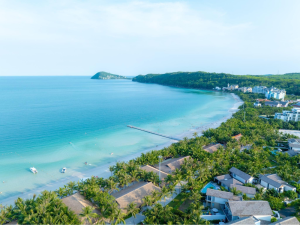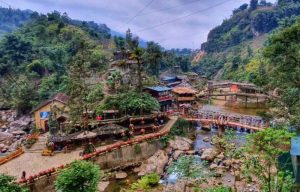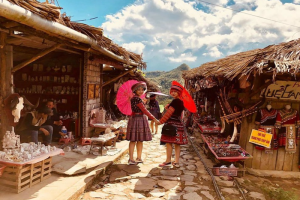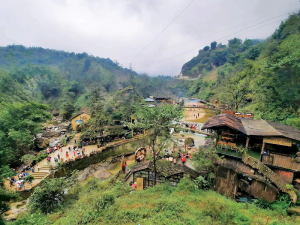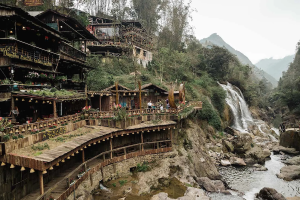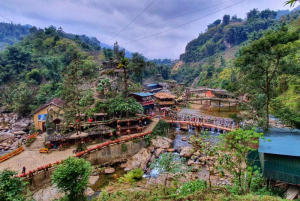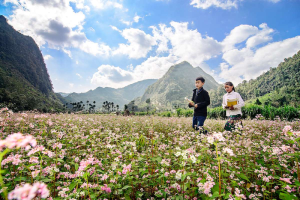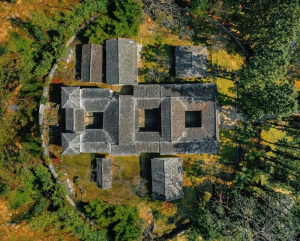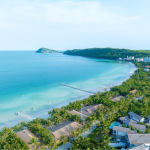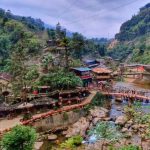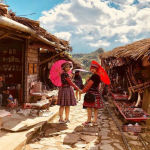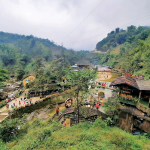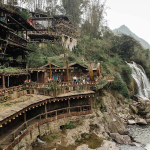
Muong Hoa Valley Vietnam is a beautiful valley in Sapa, Lao Cai Province, Vietnam. It is famous for its beautiful rice terraces and nature.
What is Muong Hoa Valley and where is it located?

Muong Hoa Valley Vietnam is about 8 kilometers from the center of Sapa town in the northwest of Vietnam. With a length of 15 kilometers, and being tranquided by two mountain ranges, the valley is one of the most beautiful places in the area.
Separating Sapa and Ban Ho Village, Muong Hoa Valley Vietnam is a wide, fertile valley with beautiful terraced rice fields, typical ethnic settlements, and ancient carved stones all over the place.
The famous valley is home to the H’Mong, Dao, and Tay people, among others. Therefore, there is a lot of cultural history for tourists to explore. People can also participate in hiking and taking pictures to recap the natural beauty.
This place becomes more beautiful in the rice harvesting season when the fields turn bright green and gold. The stunning views of terraced rice fields surrounding the valley creates one of the most beautiful views in the area.
Ethnic villages and local culture in Muong Hoa Valley
The Muong Hoa Valley loop is more than simply a beautiful place to hike; it’s a living museum of ethnic culture, traditional crafts, and historical wonders that gives guests a really immersive and enriching experience. There are several minority groups living in the valley, such as the Black Hmong, Giay, Red Dao, and Tay people. Each of these groups adds to the area’s cultural diversity. As you travel through the Muong Hoa Valley loop, you’ll see that each community has its own view of life in the northwest highlands of Vietnam.
Lao Chai Village: The center of Hmong culture

Lao Chai is a traditional Black Hmong community with wooden stilt dwellings, terraced fields that go on for miles, and views of the beautiful Fansipan Mountain. The Black Hmong people here are proficient at weaving textiles and dyeing indigo, which are skills that have been passed down through the generations. Visitors can watch hemp fabric being woven, try on traditional clothes, and listen to the sounds of Hmong musical instruments like the “khen.”
Ta Van Village: A mix of cultures

Ta Van is home to both Giay and Black Hmong people and is lower down the valley. This community with people from many different backgrounds is known for being friendly and for its cultural tourism. Ta Van is a popular place for homestays, where visitors may learn about daily living, take culinary classes, and watch cultural events at night that include folk dances and traditional melodies.
Giang Ta Chai Village: A quiet place for the Red Dao

Giang Ta Chai is a quiet Red Dao village with forest paths, hanging bridges, and waterfalls nearby. The Red Dao are easy to spot because they wear red headdresses and clothes with plenty of embroidery. Visitors can learn about Dao herbal medicine, make crafts, and enjoy the peaceful pace of village life in this quieter area of the valley.
The Tay community by the stream in Ban Ho Village

Ban Ho is the sole village in the Sapa area where the Tay ethnic group lives. It is at the end of the Muong Hoa stream. Ban Ho is less commercial than other places and gives you a real view at Tay traditions, such as their stilt dwellings and folk singing. It is surrounded by rice terraces and natural woodlands. The Tay people are known for being kind and for their delicious food, which often includes fresh fish from the stream.
Ancient Stone Field: Sounds from the past
There are hundreds of old carved stones scattered around the valley. These stones have strange symbols and human forms on them. This archeological site, which is said to be over a thousand years old, provides an air of mystery and historical depth to Muong Hoa, linking the villages of today with an ancient past.
Things to Do in Muong Hoa Valley

In Muong Thanh Valley, visitors can join local activities such as trekking through rice fields, visiting stilt-house villages, trying traditional crafts, and enjoying ethnic Thai dance and food. These experiences offer a glimpse into the daily life and culture of the local people.
Staying with a family and learning about their culture
Many villages in Muong Hoa have started community-based tourism, mainly through homestays. Travelers can share meals, learn about local customs, and participate in everyday activities when they stay overnight in a local home. Such an experience makes a short visit into a profound cultural exchange.
Try food from the highlands
You can also try regional foods in Muong Hoa Valley Vietnam. The native food is simple yet delicious, with dishes like Thang Co (a traditional Hmong stew), grilled stream fish, and Com Lam (sticky rice cooked in bamboo tubes) being some of the best.
Participants in the cultural expressions and make traditional crafts
Traditional crafts are still going strong across the region. In Y Linh Ho, one can see indigo dyeing; in Lao Chai, cloth weaving; and in other villages, bamboo carving and embroidery. These hands-on activities help you understand the creative energy of the people who live in the highlands better.
Read more: Silver Waterfall: An amazing offering from nature
Best time to visit Muong Hoa Valley

The best times to go to Muong Hoa Valley Vietnam are during the watering season (March to May) and the ripe rice season (late August to mid-September). Every season has its own special appeal, with different landscapes and experiences that will stick with you.
- Ripe Rice Season (Late August to Mid-September): The valley is blanketed in a golden blanket of ripened rice fields, making for a beautiful and romantic scene. This is the best time of year to take pictures and admire the splendor of the golden terraced fields.
- Watering Season (March – May): During the watering season, the valley is full of new green rice seedlings that have just been planted in the flooded fields. This makes a beautiful natural painting. The terraces are home to little waterfalls that show off the beauty of the landscape in layers.
But if you can pick a suitable time to visit Muong Hoa valley, you can choose other time. In each season, Muong Hoa Valley has its own unique beauty.
- Winter (December to February): The valley is often shrouded in mist and even snow, which makes it feel mysterious and enchanting.
- In the spring, trees get new leaves, flowers blossom, and the whole landscape is full of color and life.
In short, Muong Hoa Valley is gorgeous all year long. You can choose the season that has the experience you want based on what you like.
Travel tips for visiting Muong Hoa Valley

Planning ahead and being ready are key to getting the most out of your trip to Muong Hoa Valley.
- Check the weather and the state of the trails before you leave. When it rains, the paths might become slippery and hard to follow, so it’s better to be ready for everything. Make sure you bring sturdy, waterproof shoes, light, breathable clothes, and a raincoat or waterproof jacket. A helmet, sunscreen, bug repellent, a first-aid kit, offline maps, and ample drinking water are also important, especially for longer hikes.
- There aren’t many ATMs in the valley, so it’s best to get your money exchanged in Sapa town before you leave. You can get around Sapa by taxi, motorbike, or local guide.
- When you’re in the valley, be sure to follow the rules of the area. Always ask before taking pictures of anyone in the area, especially kids and old people. A local guide may also make your trip much more captivating by sharing cultural information, explaining the customs of each hamlet, and taking you on less-traveled trekking trails.
- Take some time to look at the beautiful rice terraces that make Muong Hoa Valley so well-known while you’re there. These terraced fields are not only beautiful to look at, but they also show the area’s agricultural history. You can also visit surrounding villages like Lao Chai and Ta Van, where you can see traditional stilt houses, buy handmade fabrics, and learn about local crafts.
- Stopping beside the Muong Hoa Stream gives you a peaceful pause in your trip. You may have a picnic by the lake, soak your feet in the cold stream, or just sit back and enjoy the view. Be careful when you walk near the river because the rocks can be slippery.
- If you’re going to be hiking for a long time, it’s crucial to drink enough water and have snacks. Take care of your surroundings, throw away trash appropriately, and help keep the environment safe. Lastly, don’t skip out on trying local foods like Thang Co, grilled stream fish, and fresh mountain veggies. These are important parts of getting to know the culture of the area.
Read more: Ham Rong Mountain: The most famous mountain in Sapa
Frequently Asked Questions about Muong Hoa Valley
By preparing well and respecting the local way of life, you’ll enjoy a safe, enriching, and memorable journey through Muong Hoa Valley. Even so, according to Lily’s Travel experience when consulting, these are some questions that are often asked. With nearly 20 years of experience in consulting and booking Sapa tours, we always know the problems that tourists often encounter. We even have tours that are adjusted to the interests and needs of each tourist, meeting the needs of small groups or even large groups.
Is it possible to trek without a guide?
You can definitely go to Muong Hoa Valley by yourself without a guide. You can find the Muong Hoa Valley map in either the Sapa map or the Lao Cai Province map. Because the valley is a tourism destination now, it is easy to find out on a map application. You can travel there by motorcycle, taxi, or even “Xe ôm”, which is a motorcycle taxi. The way is effortless and not too hard, especially if you’ve been to the mountains before.
How long does it take to explore the valley?
The decision of when to visit Muong Hoa Valley is up to you. It takes roughly 2 to 3 hours to walk from Sapa. Riding the mountain train only takes a few minutes. There are many things to see in Muong Hoa Valley, like Ta Van village, Lao Chai village, and the old stone field. You may visit these destinations in one day, but if you want to learn more about the culture and lives of the local people, you should stay for one or two days. You should stay in Sapa for 3 to 5 days if you want to see everything there is to see in Sapa and Muong Hoa Valley.
Is Muong Hoa Valley suitable for families or solo travelers?
Muong Hoa Valley is great for families, small groups, or people who like to travel alone because there are so many things to do.
- The terraced farmland, flowing streams, and stunning mountains of Muong Hoa Valley make it a beautiful place to live. This place is great for the whole family to relax, get some fresh air, and take pictures to remember their time there.
- A variety of activities: Families may do more than just see the sites. They can also hike, visit ethnic communities, learn about the local culture, try the herbal baths of the Red Dao people, or even take workshops to learn how to make traditional handicrafts.
If you enjoy nature and highland culture, Muong Hoa Valley is the perfect place for you. In the center of the Northwest highlands and forests, this area gives you a real, tranquil experience. You should surely not miss this gorgeous area if you go to Sapa.



